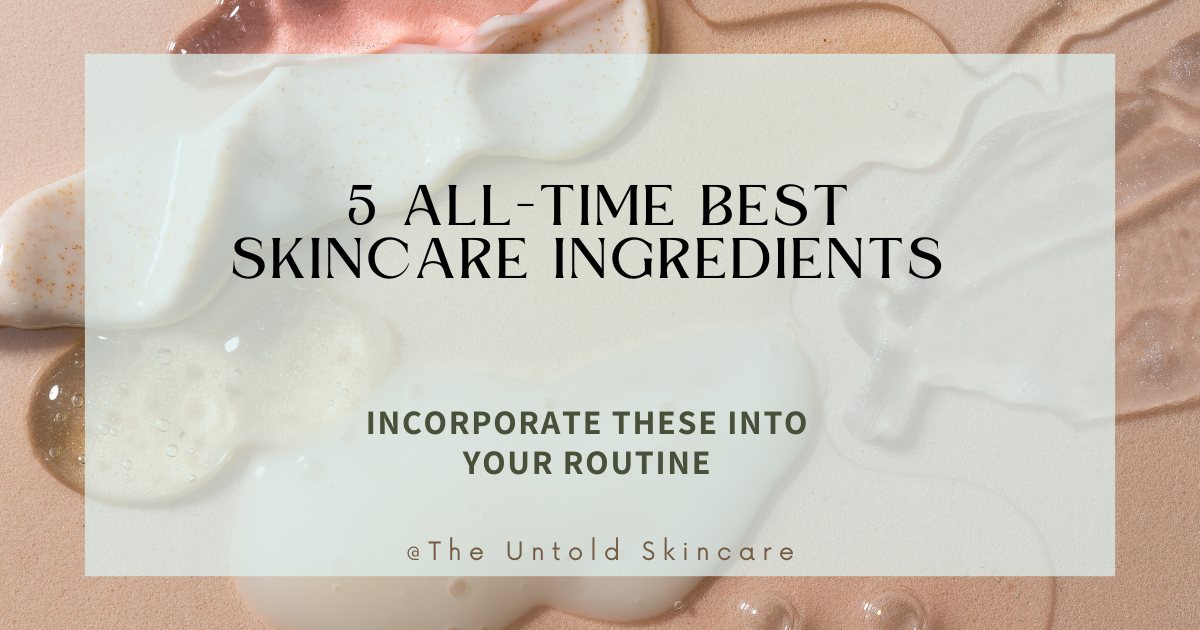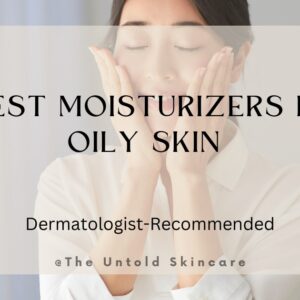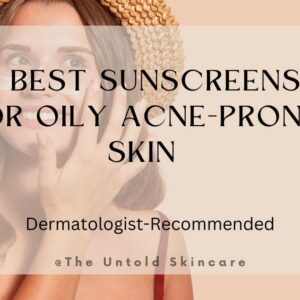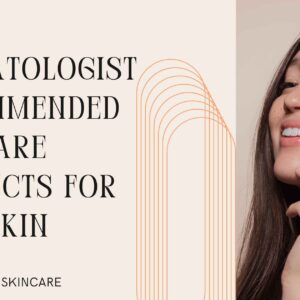Having glowing and healthy skin is a goal that most people strive to achieve.
While a good skincare routine is essential, it’s equally important to know what ingredients to look for in your skincare products.
With so many skincare ingredients available in the market, it can be challenging to find the right ones that work best for your skin type.
And trust me, choosing the right ingredients can truly help you achieve your dream skin.
Why Selecting The Right Ingredient is Important?
Selecting the right ingredient is crucial.
Different skincare ingredients are formulated to target specific skin concerns, whether it’s acne, aging, hyperpigmentation, dryness, or sensitivity. Choosing the right ingredients ensures that you address your specific skincare goals effectively.
Using the right ingredients in your skincare routine helps you create a balanced and tailored regimen. It ensures you’re not overloading your skin with unnecessary products while giving you the best chance of achieving your desired results.
Also, selecting ingredients suitable for your skin type and concerns minimizes the risk of irritation, redness, and adverse reactions. Using products with inappropriate ingredients can exacerbate existing issues or can even cause new ones.
Additionally, skin varies from person to person. What works for one individual may not work for another. Selecting the right ingredients allows you to personalize your skincare routine based on your unique skin type, concerns, and goals.
Factors to Consider While Selecting Skincare Ingredients
Selecting skincare ingredients requires careful consideration of several factors to ensure you choose the right one for your skin type and specific concerns.
Some key factors to keep in mind are:
Skin Type: Determine your skin type, whether it’s oily, dry, combination, sensitive, or normal. Different ingredients are better suited for specific skin types, so understanding your skin type is essential for selecting the right products.
Skin Concerns: Identify your primary skincare concerns, such as acne, aging, hyperpigmentation, redness, sensitivity, or dryness. Choose ingredients that target these concerns effectively.
Ingredient’s Purpose: Consider what you want the ingredient to do for your skin. Some ingredients focus on hydration, while others address issues like wrinkles, dark spots, or acne. Ensure that the ingredient aligns with your skincare goals.
Ensure it is compatible with the other products you use and doesn’t cause interactions or reduce the effectiveness of other products.
Be aware of any sensitivities or allergies you may have to certain ingredients. Avoid ingredients that have caused adverse reactions in the past, and look for hypoallergenic or fragrance-free options if you have sensitive skin.
5 Best Skincare Ingredients
Now that you know what factors to consider while selecting skincare ingredients, let’s start discussing some of the best skincare ingredients that can help you transform your skin:
Retinol
When it comes to skincare ingredients, one that has been gaining immense popularity in recent years is retinol. Renowned for its incredible ability to rejuvenate and brighten the skin, Retinol can be considered one of the best all-round skincare ingredients.
Retinol is a form of vitamin A, and it is a widely used skincare ingredient known for its various benefits for the skin. It’s part of the retinoid family, which includes both over-the-counter options like retinol and prescription-strength retinoids like tretinoin.
Retinol is available in various forms such as gel, serums, ointments, and creams but the serum is considered its most effective form.
Benefits of Retinol
- Retinol is renowned for its anti-aging properties. It promotes collagen production, a protein that helps maintain skin elasticity and reduces the appearance of fine lines and wrinkles, leading to smoother, more youthful-looking skin.
- One of the most amazing benefits of retinol is its ability to increase skin cell turnover. This helps shed old, damaged skin cells and replace them with new, healthier ones, resulting in improved skin texture.
- Retinol helps in fading dark spots, sunspots, and other forms of hyperpigmentation, leading to a more even and radiant skin tone
- It can also help prevent and treat acne by unclogging pores, reducing the formation of blackheads and whiteheads, and regulating oil production.
How to Use it?
Using retinol in your skincare routine requires some care and attention, as it may cause skin irritation if not used correctly.
If you’re new to retinol, begin with a lower concentration product (usually around 0.25% to 0.5%) to allow your skin to adjust. This minimizes the risk of excessive dryness or irritation.
Retinol is best applied at night because it can make your skin more sensitive to sunlight. Take a pea-sized amount and apply it after cleansing and before moisturizing.
Do not ever forget to use sunscreen while going out as retinol makes your skin more susceptible to sun damage.
Initially, use retinol 2-3 times a week to allow your skin to acclimate. As your skin builds tolerance, you can gradually increase the frequency to every other night or nightly, as recommended by your dermatologist or the product instructions.
And it is usually recommended not to combine any other actives with retinol as it can increase the risk of irritation.
How Long Does it Take to Give Results?
During the first few weeks of using retinol, you may not see any noticeable changes in your skin. In fact, you may experience some initial side effects like dryness, redness, or peeling as your skin adjusts to the product. This is often referred to as the “purging period.”
By the end of the first month, you might begin to notice some subtle changes.
Around the two to three-month mark, you will begin to see more noticeable improvements. Fine lines and marks may appear less prominent, and your skin’s texture will continue to improve.
Side Effects of Retinol
Retinol’s side effects are likely to be most noticeable in the initial stages. All the side effects start to gradually fade away after your skin gets used to it.
Some common side effects of retinol include:
- Dryness and peeling
- Redness and irritation in sensitive or dry skin
- Make your skin more sensitive to UV radiation.
- Increases skin’s sensitivity
Benzoyl Peroxide
Benzoyl peroxide is a widely used ingredient in skincare products that is primarily used to treat acne. It is also an FDA-approved prescription medication for acne that is highly capable of killing acne-causing bacteria.
It works by releasing oxygen into the hair follicles, creating an oxygen-rich environment that is toxic to the bacteria (Propionibacterium acnes) that contribute to the formation of acne. By reducing the number of bacteria on the skin, it helps prevent new acne from forming.
It is available in various forms, including creams, gels, lotions, foams, and washes. It can be found in concentrations ranging from 2.5% to 10%, with lower concentrations typically recommended for individuals with sensitive or dry skin.
Benefits of Benzoyl Peroxide
- Effective in reducing acne lesions, including pimples, blackheads, and whiteheads.
- It has anti-inflammatory effects and can help calm the redness and swelling associated with acne.
- It has a mild exfoliating effect on the skin’s surface and helps to remove dead skin cells, preventing them from clogging pores.
- It helps to stop causing new acne by keeping the skin clear of bacteria and preventing clogged pores.
How to Use it?
The best form of Benzoyl Peroxide for you actually depends on a lot of factors but it is generally preferred to use it as a cleanser as they are gentler to the skin and are super effective as well.
The leave-on form of Benzoyl Peroxide is reported to be irritating for many.
The next thing you need to look at is its concentration. Benzoyl peroxide products come in different strengths, typically 2.5%, 4%, and 10%. The safer side and the most recommended one is 4%.
Wet your face with lukewarm water and gently massage your cleanser onto your wet face. Strictly avoid getting the cleanser in your eyes, nose, or mouth. Leave it for about 1 minute and then rinse it off properly with lukewarm water.
How Long Does it Take to Give Results?
It depends on several factors.
Normally if you have mild acne, you may start seeing results within a few weeks or so. But if you have moderate to severe acne, it may take about 2 months before you see significant improvements.
Side Effects of Benzoyl Peroxide
Benzoyl peroxide is generally considered safe and effective for treating acne when used as directed. However, like any medication, it can cause side effects in some individuals.
- Drying to the skin causing flakiness
- Can bleach hair, clothes, and fabrics
- Make skin sensitive to UV radiation
Vitamin C
Vitamin C, also known as ascorbic acid, has gained significant popularity in the skincare industry for its remarkable benefits in achieving a radiant and glowing complexion.
It’s an antioxidant, which means it helps protect the skin from the damaging effects of free radicals and supports overall skin health.
It is one of the best skincare ingredients for getting a young-looking and glowing skin complexion and several studies have validated its potential too.
Benefits of Vitamin C
- Vitamin C is a potent antioxidant that helps neutralize free radicals, thus preventing premature aging, including fine lines, wrinkles, and age spots.
- Vitamin C can brighten the skin by reducing the appearance of hyperpigmentation, dark spots, and uneven skin tone.
- It also helps in boosting collagen production.
- Vitamin C has anti-inflammatory properties that can help soothe irritated or inflamed skin.
How to Use it?
Using vitamin C in your skincare routine is relatively simple, but it’s important to follow a few guidelines to maximize its benefits and minimize the risk of irritation.
Vitamin C is available in various forms including serums, creams, and masks. It is highly effective in any form but vitamin C serums are more preferred one.
It’s best to use vitamin C products in the morning, regularly before applying sunscreen. The recommended concentration of Vitamin C for sensitive skin is 10%. However, people with more resilient skin can go up to 15-20%.
How Long Does it Take to Give Results?
You may start seeing a brighter complexion within few weeks of regular application of vitamin C but for addressing fine lines and wrinkles, it may take few more months.
Side Effects of Vitamin C
The most common side effect of topical vitamin C is mild skin irritation. This irritation is often temporary and tends to disappear as your skin starts adjusting to the product.
Besides, there are not much of side effects reported as long as you are not using very high concentration.
Hyaluronic Acid
Known for its remarkable ability to hydrate and plump the skin, hyaluronic acid has become a staple in many skincare routines.
Hyaluronic acid is a naturally occurring substance in our bodies, responsible for maintaining moisture levels in the skin. What makes it one of the best ingredients in skincare is its unique ability to hold significant amount of water. It can hold upto 1000 times its weight in water.
Benefits of Hyaluronic Acid
- Its most significant benefit is its ability to attract and retain water. It helps to hydrate the skin, helping it appear plumper and more youthful.
- HA helps combat dry and flaky skin by locking in moisture. This can be particularly beneficial for individuals with dry or dehydrated skin.
- By providing intense hydration to the skin, HA can help reduce the appearance of fine lines and wrinkles. Well-hydrated skin tends to look smoother and firmer.
- HA has soothing properties, which can help calm irritated or sensitive skin. It is often used in products designed for those with skin conditions like rosacea or eczema.
- It is also highly effective in wound healing as it promotes the growth of cells and tissues and potentially reduces scarring.
How to Use it?
Hyaluronic acid can be used in various forms, including serums, creams, masks, and even as a moisturizer. Anyone with any skin type can use it. And it can typically be used both morning and evening as part of your skincare routine
If you are using its serum, just apply few drops of it onto clean, damp skin, gently massaging it in upward motions. Then follow up with a moisturizer to seal in the hydration.
Hyaluronic acid sheet masks are also quite popular and extremely effective as well. Gently place the mask on your face and press it down to ensure good contact with your skin. Smooth out any air bubbles or wrinkles in the mask to ensure even coverage.
Leave it for 20-30 minutes and then pill it off. Do not wash your face after removing the mask and allow the excess serum to get absorbed by the skin.
How Long Does it Take to Give Results?
Hyaluronic acid can provide immediate hydration and plumping effects. You may notice your skin looking more moisturized and supple shortly after application. However, long-term benefits, such as reduced fine lines and improved skin texture, may take about 2-3 weeks of consistent use to become noticeable.
Side Effects of Hyaluronic acid
Hyaluronic acid is generally safe for every skin type and it rarely leads to any side effects. The only way it may lead to negative effects is if improperly combined with other actives.
Also Read: 6 Worst Skincare Ingredients to Avoid in Skincare
Azelaic Acid
Azelaic acid is a compound found naturally in grains such as wheat and barley and is also produced as a by-product of metabolism of certain types of yeast.
It is a popular skincare ingredient that can help with various skin issues, including acne, dark spots, scars, rosacea, and many more. It is also widely used in treating melasma and hyperpigmentation.
One of the most significant benefits of azelaic acid that has made it quite popular in skincare is that it is milder than other similar ingredients which makes it more suitable for people with sensitive skin and serious skin concerns like rosacea.
Benefits of Azelaic Acid
Azelaic Acid is one of those few skincare ingredients that can provide all-round benefits to the skin. Here are the key benefits of azelaic acid in skincare:
- Azelaic acid has antibacterial properties that inhibit the growth of acne-causing bacteria, such as Propionibacterium acnes.
- Azelaic acid has anti-inflammatory properties, which help reduce redness, swelling, and inflammation associated with acne lesions.
- Azelaic acid inhibits the production of melanin, the pigment responsible for dark spots. This makes it effective for fading hyperpigmentation, including post-inflammatory hyperpigmentation and melasma.
- Azelaic acid has a mild exfoliating effect, promoting the shedding of dead skin cells.
How to Use it?
Azelaic acid is available in various formulations, including creams, gels and serums.
Use a small amount of the azelaic acid product and apply it evenly to the affected areas of your skin. It’s essential to follow the product’s instructions regarding the amount to use and the frequency of application.
Typically, azelaic acid is applied once or twice a day, but this can vary depending on the product and your skin concern.
How Long Does it Take to Give Results?
If you’re using azelaic acid to treat acne, you may start to see some improvement in a few weeks, but it often takes 8 to 12 weeks of consistent use to see significant results. The reduction in acne lesions and overall improvement in skin texture should become more noticeable over time.
For addressing hyperpigmentation issues, such as post-inflammatory hyperpigmentation or melasma, it typically takes several weeks to a few months to see visible fading of dark spots and an improvement in overall skin tone.
Side Effects of Azelaic Acid
Azelaic acid is generally considered safe and well-tolerated, however, there is slight possibility of irritation in some people. Since it is a mild exfoliant, it can be drying and irritating in some rare cases.
Best Ingredients for Acne
When choosing products to address acne, look for ingredients that have been proven to help reduce breakouts, unclog pores, and soothe inflammation.
Benzoyl peroxide is one of the best skincare ingredients for acne since its antimicrobial property helps to kill acne-causing bacteria.
Salicylic acid is another quite effective ingredient for treating acne. It penetrates deep into the pores to dissolve excess oil and exfoliate dead skin cells. It is effective at preventing and treating both non-inflammatory and inflammatory acne.
Another popular anti-acne ingredient is azelaic acid. It not only kills acne causing bacteria but also helps to reduce dark spots and acne scars.
Best Ingredients for Anti-Aging Effects
Retinoids are arguably the best skincare ingredient for anti-aging benefits. They are derivatives of vitamin A and are known for their ability to stimulate collagen production, increase cell turnover, and improve skin texture. They can also reduce the appearance of fine lines and wrinkles.
Similarly, Antioxidants like vitamin C, vitamin E, and coenzyme Q10 can help protect the skin from free radical damage, which is a significant contributor to aging. They can also brighten the skin and improve overall tone.
Hyaluronic acid, on the other hand, is also considered one of the best for anti-aging benefits. One of the primary benefits of HA is its exceptional ability to retain moisture.
As we age, the skin’s natural moisture content decreases, leading to dryness and the formation of fine lines and wrinkles. HA helps to hydrate and plump the skin, making it look more youthful and reducing the appearance of wrinkles and fine lines.
Best Ingredients for Bright Skin
Vitamin C is quite popular as a skin-brightening agent. It is a powerful antioxidant that can brighten the skin, fade hyperpigmentation and dark spots, and promote collagen production.
Niacinamide, also known as vitamin B3, is a versatile skincare ingredient that can also contribute to brighter, more radiant skin.
Niacinamide can help fade dark spots and hyperpigmentation by inhibiting the transfer of melanin (the pigment responsible for skin color) to the skin’s surface. It also promotes cell turnover, which can lead to smoother skin with a finer texture.
Also Read: 7 Skincare Ingredients You Should Never Mix
Best Ingredients for Skin Repair and Redness
Ceramides are essential for a healthy skin barrier. They help to hold skin cells together, creating a tight, protective seal. This barrier function is essential for skin repair because it prevents excessive moisture loss and protects against external irritants.
Another ingredient with skin repairing benefits is Panthenol. Panthenol is a humectant, which means it attracts and retains moisture from the environment. When applied topically, it can help hydrate the skin by drawing water into the skin’s outer layer creating a perfect environment for natural healing process.
Hyaluronic acid is highly effective in reducing redness. HA has a soothing and calming effect on the skin. It can help alleviate skin irritation and redness caused by various factors, such as sunburn, windburn, or skin sensitivity.
By providing a hydrating and soothing environment for the skin, HA can contribute to the reduction of redness.
Conclusion
Selecting the right ingredient is extremely crucial for your skin and can help you get your dream skin.
Retinol is an ingredient that is well-known for its anti-aging benefits. Benzoyl peroxide is popular for treating acne and stops causing new acne.
Vitamin C can make your skin look young and have glowing skin complexion and hyaluronic acid keeps the skin fully hydrated. Similarly, azelaic acid inhibits the growth of acne-causing bacteria and helps fade dark spots.
By incorporating these ingredients into your regimen, you’ll be well on your way to achieving the glowing skin you’ve always dreamed of. So go ahead, indulge in the power of these skincare secrets and let your inner radiance shine through.





